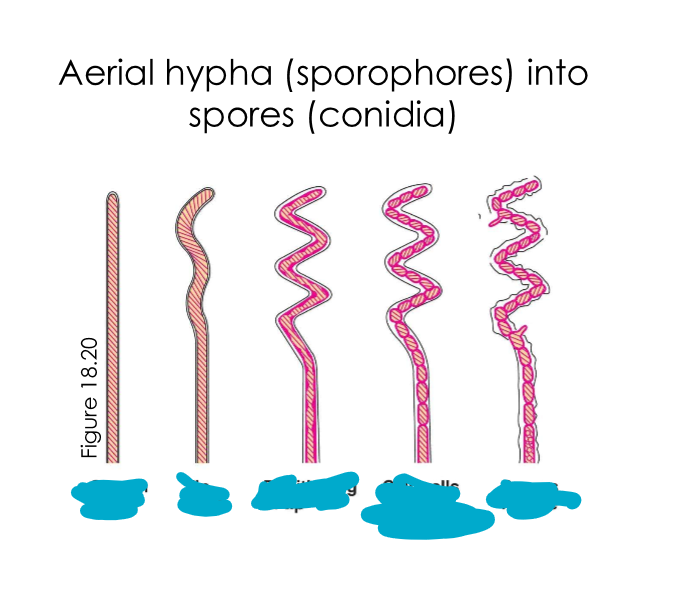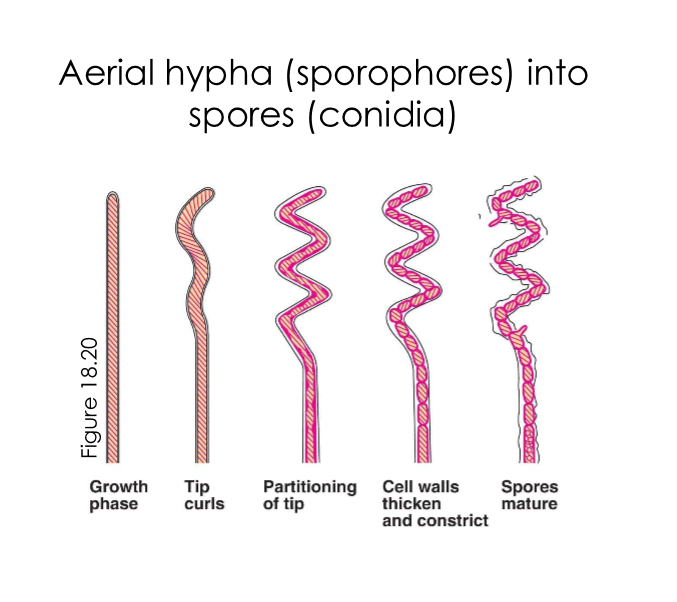Actinobacteria
1/21
There's no tags or description
Looks like no tags are added yet.
Name | Mastery | Learn | Test | Matching | Spaced |
|---|
No study sessions yet.
22 Terms
Actinobacteria - mycobacterium (high GC) contain what in their cell walls?
Contains lipids called mycolic acids in cell wall
Actinobacteria - mycobacterium (high GC) exhibit acid-fastness, which is?
Dye basic fuchsin is not removed by acid-alochol wash due to dye’s interaction w/ mycolic acids
Are actinobacteria - mycobacterium (high GC) pathogens to humans?
Yes
Actinobacteria - mycobacterium (high GC) are resistant to many chemicals. Why?
High lipid content of cell wall
Many actinobacteria - mycobacterium (high GC) contain pigments, which are?
Carotenoids
Filamentous actinobacteria
Streptomyces and relatives (high GC), which are nutritionally versatile organisms that are filamentous and form branching mycelia.
actinobacteria form spores called?
conidia
How are conidia (filamentous actinobacteria) formed?
In sporophores, aerial filaments that are important in the classification of the organisms.
Streptomyces
Produce important antibiotics, found mostly in soil, type of (filamentous actinobacteria)
Actinobacteria can produce geosmins, which do what?
Provide soil with its earthy smell
Actinobacteria (high GC gram positives) - describe what Robert Koch said about tuberculosis in 1882 (main message)
Number of fatalities,1/3 Europeans will die, 1/7 of all humans.
Actinobacteria (high GC gram positives) - mycobacterium
What do they contain and exhibit?
Lipids called mycolic acids in cell wall. Exhibit acid-fastness
Actinobacteria (high GC gram positives) - mycobacterium
Are they pathogens?
Human pathogens (impact nerves, like nose or limbs, and/or lungs). E.g., mycobacterium leprae (leprosy), mycobacterium tuberculosis
Actinobacteria (high GC gram positives) - mycobacterium
Is it resistant to many chemicals?
Yes, high lipid content of cell wall = waxy = prevent chemicals from taking affect.
Mycobacterium leprae (leprosy)
Affects more than 10 million ppl world-wide. Humans & armadillos only known hosts, cannot be cultured in the lab.
Mycobacterium species and most other actinobacteria are normally occurring…? Are they harmful?
Soil bacteria, many are harmless but many can cause disease.
Filamentous actinobacteria includes?
Streptomyces and relatives
Filamentous actinobacteria characteristics
Filamentous, branching mycelia, produce antibiotics
filamentous actinobacteria have what kind of spores?
Desiccation-resistant spores. Conidia (formed in sporophores)
Filamentous actinobacteria have what kind of smell and why?
Strong smell to soil, geosmins


____ % of streptomyces isolates ______. Already ____ distinct compounds, ____ find practical use in human or vet medicine, agriculture, industry.
~50, produce antibiotics, >500, >60